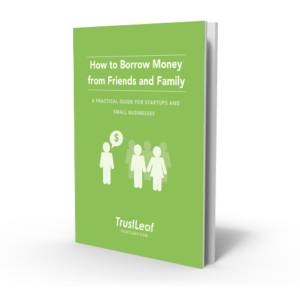
Everyone has been talking about crowdfunding lately, but what about momfunding? Or friendfunding? Earlier this week, family loans site TrustLeaf released their first guide on “How to Borrow Money from Friends and Family.” For any small business owner who’s done this kind of loan before, the value of doing it right cannot be understated.
Unlike crowdfunding, where entrepreneurs ask for donations from strangers (sometimes with a gift in return) TrustLeaf helps small business owners raise money through their existing social and family network. “Crowdfunding is great if you have a sleek prototype or a chic new fashion line, but doesn’t make as much sense for say, an auto repair shop.” says Anson Liang, TrustLeaf’s founder.
38% of all US small businesses start out with friends and family loans; on average, borrowing $25,000. Compare that with popular crowdfunding site Indiegogo, which only brings in about $1,000 on average per campaign. Kickstarter performs better, but the vast majority of campaigns raise less than $10,000, which in turn is less than half of friends and family loans on average.
Friends and family loans are not just for entrepreneurs with humble small-town goals: in the history of American business, they’ve been the source for some of the biggest and most profitable companies ever. Walmart founder Sam Walton opened his first store after borrowing $20,000 from his father-in-law. Even Warren Buffett, who at several times in his life has been ranked by Forbes as the richest man in the world, wouldn’t be where he is if his older sister Dorothy and others hadn’t lent him money to start his first business. (After earning over $100 million as a result of her early-stage investments with her younger brother, she’s probably pretty glad she made that decision!)
There are plenty of business bloggers giving generic advice to people who are asked by family members for a business loan, but there are few articles with clear, actionable advice for the entrepreneurs who actually need to go around and do the asking.
Some of TrustLeaf’s advice includes presenting two to three loan options to your potential lenders, so the lender can choose their preferred term length and interest rate without feeling like they’re haggling. Also, the business owner should give a range of the amount they need rather than specifying an exact amount, which can make the lender feel like it’s all-or-nothing.
The most important advice the guide provides is how to pay it back, or how to choose the best way you’d like to pay it back. A due date (AKA maturity date) isn’t enough. You’d think the only issue here is whether a family business loan gets paid back, but what happens if the borrower thinks they just need to pay a lump sum at the end, and the lender expects monthly payments starting immediately? Luckily, most written agreements, whether they’re from a simple legal template site or a full-service platform like TrustLeaf, require that the repayment schedule be listed.
The most valuable tool TrustLeaf has up its sleeve? A fully-integrated repayments system that will make the repayment process easy for both lender and borrower when it’s released in early July. Long gone are the days of verbal agreements and handshakes. For most of us who’ve ever had a verbal family financial agreement before, I think we can all agree: good riddance!
Daniel Lieser is the Co-Founder and Business Development Manager for TrustLeaf.com, a friends and family loans platform for small businesses and startups. To reserve your free copy of TrustLeaf’s Friends and Family Loans Resource Guide today, click here!
